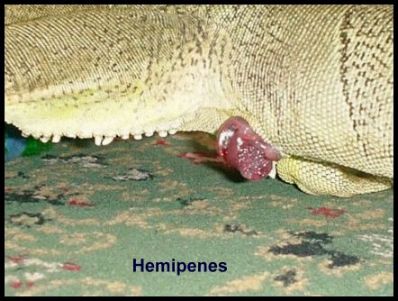
Melissa
Kaplan's
Herp Care Collection
Last updated
January 1, 2014
Prolapse of Cloacal Tissue and Hemipenes
©1996 Melissa Kaplan
Definitions
|
cloaca |
A passage used for eliminating fecal, urinary and reproductive discharges. From the Latin word meaning "sewer". Reptiles, like birds, have a chamber into which the contents of the bladder and anus flow prior to being eliminated from the body. This chamber lies inside the vent (venter). |
|
hemipene |
The male reproductive organ in snakes and lizards, kept inverted in the tail until needed. (see illustration). Chelonians have a single penis. (See the Hemipenes article for photos of everted box turtle penis and snake hemipenes.). |
|
prolapse |
Turning out; inside out. Eversion |
Typical normal eversion of iguana hemipene seen when the iguana defecates, deposits seminal plugs or other seminal discharge, or he just decides to flash his keeper. To see larger versions, just click on the photo. Photos courtesy of Steve Woodward; hemipenes courtesy of Spike Woodward.
A prolapse is the eversion of tissue into an area where it should not be. In iguanas (and reptiles in general), three types of prolapse may be occur that can be seen by the owner. They are potentially very serious, and if they do not correct themselves within a very short period of time, the iguana must be seen by a reptile vet.
Reptiles are like birds in that they have a single chamber into which feces and urates are deposited before being voided. Through this same chamber passes sperm, and eggs (or live babies, in viviparous species, hatchlings in ovoviviparous species) in the female. This chamber, the cloaca, is found just inside the vent (which is properly called venter). The paired male iguana reproductive organ, called the hemipenes, is kept tucked into the tail, pointed towards the tip of the tail. When the hemipene is everted, it, too, passes through the cloaca to the vent.
In the normal course of defecation, the male hemipenes may be everted, that is, will be forced out of the vent. They will revert back (be pulled back in by the muscles) into their normal position within a few moments. During breeding season, males will frequently evert their hemipenes in conjunction with depositing some seminal material, especially when being greeted by their female owner,. As with eversion during defecation, the hemipenes will rapidly retract into the tail.
If the iguana is constipated, either due to dehydration, impaction due to a foreign object, or from being heavily parasitized, the strain of trying to defecate may result in either a section of the colon or cloacal tissue, or one or both hemipenes, being everted through the vent. Severe parasite infestation and dystocia may also result in prolapsed tissue. In severe cases, or if the animal is already weakened by the underlying condition, he or she may not be able to retract the tissue. If left outside the body, it may become contaminated with feces, urates, or food, or other matter, and will start to dry out. If not cleaned and replaced, the tissue will die and require amputation.
You can try soaking the iguana in a cool bath to which sugar has been added. Heavy concentrations of sugar in the water will act to draw out the fluids engorging the swollen everted tissue; this may reduce it enough to be inverted by the lizard. The tissue may be rinsed with fresh water and Betadine, and carefully pushed back in with a gloved finger lubricated with KY Jelly (the type without the spermicde). Extreme care must be taken in doing this as, if the colon contains fecal matter and the colon tissue is pierced in the attempt to replace it, severe, even fatal contamination and injury may result. If the soaking does not work within an hour, and you do not wish to attempt manual replacement, the iguana should be placed on a damp towel and taken to the vet as quickly as possible.
Some lizards may repeatedly prolapse. In these instances, you must take your iguana to the veterinarian. If the prolapse is a hemipene, it may safely be amputated. If only one is amputated, the lizard may still be able to breed. Suturing may be required to try to prevent the colon or cloacal tissue from prolapsing again. If it does continue to happen, however, surgery may be necessary to suture the colon to the wall of the coelomic cavity. Cloacal pexy (fixation, i.e, suturing in place) or oviduct removal may also be recommended in these cases.
Related Articles

